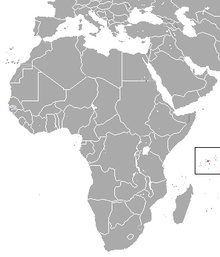- Seychelles Sheath-tailed Bat
-
Seychelles sheath-tailed bat Conservation status Scientific classification Kingdom: Animalia Phylum: Chordata Class: Mammalia Order: Chiroptera Family: Emballonuridae Genus: Coleura Species: C. seychellensis Binomial name Coleura seychellensis
(Peters, 1868)
Seychelles Sheath-tailed Bat range The Seychelles sheath-tailed bat (Coleura seychellensis) is a sac-winged bat. It occurs in the central granitic islands of the Seychelles Islands north of Madagascar. It was probably abundant throughout the Seychelles in the past[citation needed], but it has declined drastically and is now extinct on most islands.
It is one of the most endangered animals, fewer than 100 are believed to exist in the world. The Seychelles sheath-tailed bat has suffered from habitat deterioration due to the effects of introduced plant species. The largest surviving roost is on Silhouette Island, although small roosts do exist in Mahé and also Praslin and La Digue islands.
The weight of Seychelles sheath-tailed bats averages about 10 - 11 g (0.4 oz). Bats in this genus generally roost in caves and houses, in crevices and cracks. In the 1860s, the Seychelles sheath-tailed bat was reported to fly around clumps of bamboo towards twilight, and in the daytime to be found roosting in the clefts of the mountainside facing the sea and with a more or less northern aspect. These hiding places were generally covered over with the large fronds of endemic palms. The Seychelles sheath-tailed bat is insectivorous. Its colonies are apparently divided into harem groups.
It has been the focus of recent intensive research, which has determined that it is a species associated with small clearings in forest where it feeds on a wide variety of insect species. Observations of coastal or marsh feeding are thought to be bats that have been forced into feeding in unusual situations due to habitat deteroration. Although the species is not a specialist and has a high reproductive potential it is very vulnerable to disturbance and requires several roost sites within healthy habitat (see references below).
Further reading
- Burgess, H. & Lee, N. 2004 A behavioural study of the Silhouette sheath-tailed bat (Coleura seychellensis). Phelsuma 12; 69-77
- Gerlach, J. 2004 The bats of Silhouette Island, Seychelles. Phelsuma 12; 78-90
- Gerlach J & Taylor, M. 2006 Habitat as a critical factor in the decline of the Seychelles Sheath-Tailed Bat Coleura seychellensis. Acta Chiopterologica 8; 129-139
External links
- Mickleburgh et al. (2004). Coleura seychellensis. 2006. IUCN Red List of Threatened Species. IUCN 2006. www.iucnredlist.org. Retrieved on 11 May 2006. Database entry includes justification for why this species is critically endangered
- ARKive - images and movies of the Seychelles sheath-tailed bat (Coleura seychellensis)
- Animal Info
- Conservation of the Seychelles sheath-tailed bat
Categories:- IUCN Red List critically endangered species
- Fauna of Seychelles
- EDGE Species
- Emballonuridae
Wikimedia Foundation. 2010.

